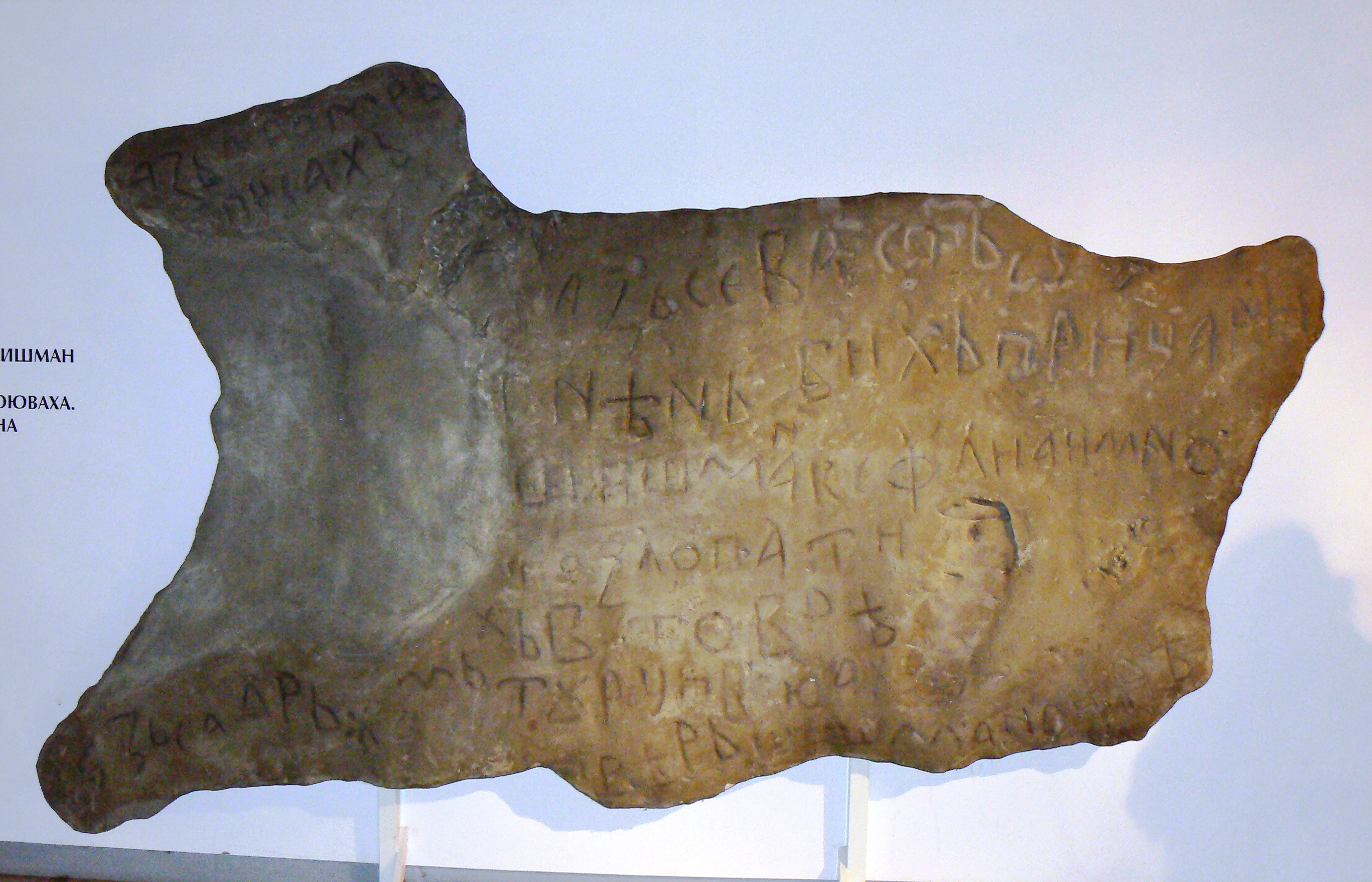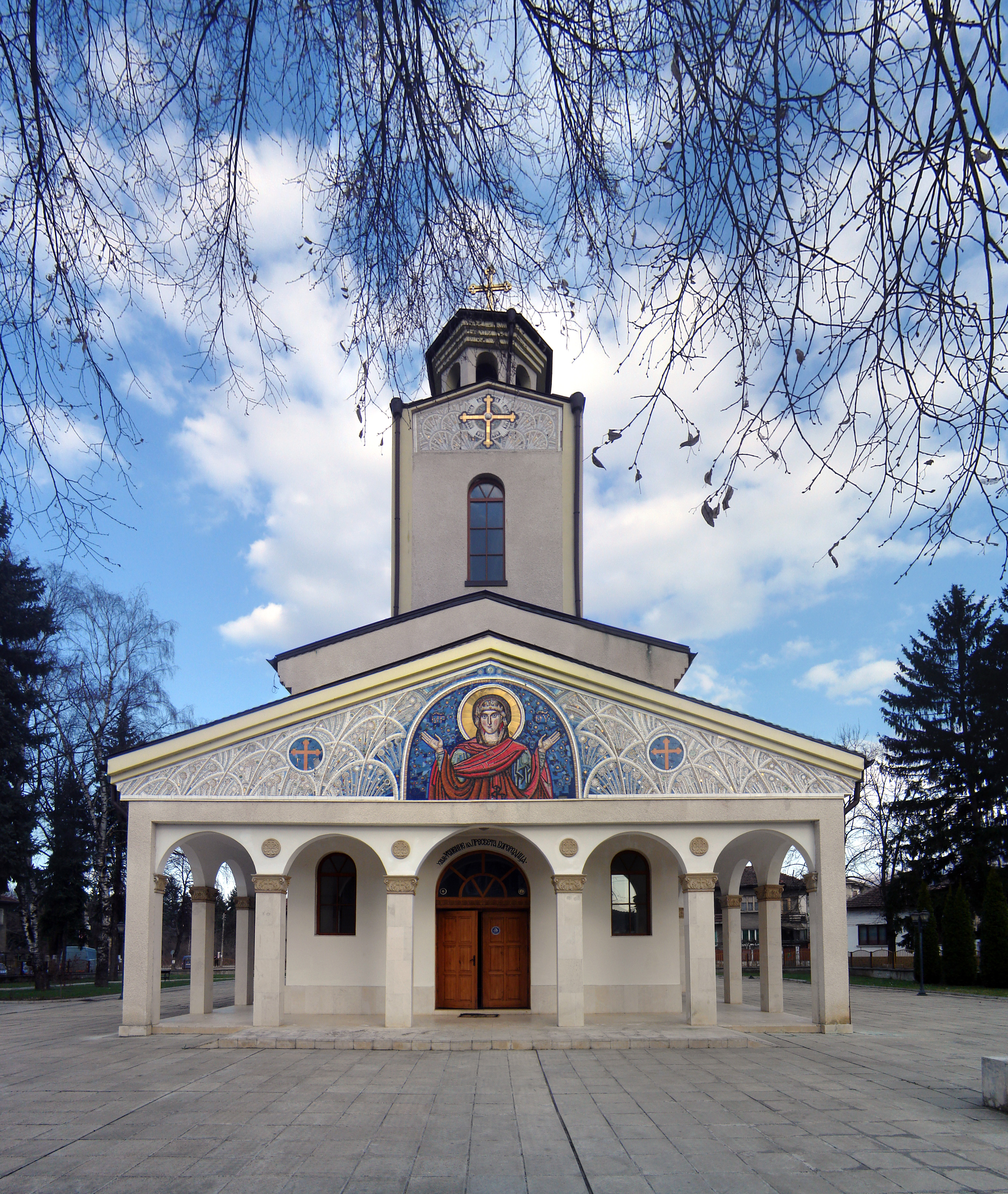|
Bozhenishki Urvich
Bozhenishki Urvich is a ruined fortress on the northern slopes of Lakavishki ridge in the western Balkan Mountains, 3 km south of village Bozhenitsa and 20 km from the town of Botevgrad, Bulgaria. It is situated at an elevation of 750 m. An asphalt road leads to the resting base "Urvich". From there, a marked path leads to the remains of the fortress. The path takes around 20 minutes by foot. The secrets of the fortress were discovered in 1918, when, after a storm, people discovered a medieval inscription among the roots of a fallen tree. The Bozhenishki inscription was first read and interpreted by Academician Petar Mutafchiev. He noted that the author (the hewer) of the inscription "has not thought about the size of the surface. He started with large letters and started decreasing the size of the letters and increasing the length of the rows as he noticed there is not enough space...". The inscription reads: ''Аз Драгомир писах. Аз, севаст Огнян, ... [...More Info...] [...Related Items...] OR: [Wikipedia] [Google] [Baidu] |
Fortress
A fortification is a military construction or building designed for the defense of territories in warfare, and is also used to establish rule in a region during peacetime. The term is derived from Latin ''fortis'' ("strong") and ''facere'' ("to make"). From very early history to modern times, defensive walls have often been necessary for cities to survive in an ever-changing world of invasion and conquest. Some settlements in the Indus Valley civilization were the first small cities to be fortified. In ancient Greece, large stone walls had been built in Mycenaean Greece, such as the ancient site of Mycenae (famous for the huge stone blocks of its 'cyclopean' walls). A Greek ''Towns of ancient Greece#Military settlements, phrourion'' was a fortified collection of buildings used as a military garrison, and is the equivalent of the ancient Roman, Roman castellum or English language, English fortress. These constructions mainly served the purpose of a watch tower, to guard certa ... [...More Info...] [...Related Items...] OR: [Wikipedia] [Google] [Baidu] |
Balkan Mountains
The Balkan mountain range (, , known locally also as Stara planina) is a mountain range in the eastern part of the Balkan Peninsula in Southeastern Europe. The range is conventionally taken to begin at the peak of Vrashka Chuka on the border between Bulgaria and Serbia. It then runs for about , first in a south-easterly direction along the border, then eastward across Bulgaria, forming a natural barrier between the northern and southern halves of the country, before finally reaching the Black Sea at Cape Emine. The mountains reach their highest point with Botev Peak at . In much of the central and eastern sections, the summit forms the watershed between the drainage basins of the Black Sea and the Aegean. A prominent gap in the mountains is formed by the sometimes narrow Iskar Gorge, a few miles north of the Bulgarian capital, Sofia. The karst relief determines the large number of caves, including Magura, featuring the most important and extended European post-Palaeolithic cave ... [...More Info...] [...Related Items...] OR: [Wikipedia] [Google] [Baidu] |
Botevgrad
Botevgrad ( bg, Ботевград ) is a town in western Bulgaria. It is located in Sofia Province and is close to Pravets. Botevgrad lies 47 km from Sofia. History and name The village was called Samundzhievo (Самунджиево) until it was elevated to town status at the end of 1865 under the name of Orhanie (Bulgarian language: Орхание; Ottoman Turkish: اورخانيه). On 1 December 1934 the town was named Botevgrad (Ботевград) after Hristo Botev. Geography Botevgrad and its hinterland are located in an elliptical valley with a total area of 5,066 km². The municipality covers parts of the Western Stara Planina mountain — Razhana, Murgash, Bilo Mountains, Bulgaria, Bilo and Golyama Planina and some parts of the Northern Balkan. Vitinya Pass connecting Northern Bulgaria with Southern Bulgaria and the proximity of the capital contribute to its strategic location. Botevgrad municipality borders the following municipalities: Pravets, Etropo ... [...More Info...] [...Related Items...] OR: [Wikipedia] [Google] [Baidu] |
Bulgaria
Bulgaria (; bg, България, Bǎlgariya), officially the Republic of Bulgaria,, ) is a country in Southeast Europe. It is situated on the eastern flank of the Balkans, and is bordered by Romania to the north, Serbia and North Macedonia to the west, Greece and Turkey to the south, and the Black Sea to the east. Bulgaria covers a territory of , and is the sixteenth-largest country in Europe. Sofia is the nation's capital and largest city; other major cities are Plovdiv, Varna and Burgas. One of the earliest societies in the lands of modern-day Bulgaria was the Neolithic Karanovo culture, which dates back to 6,500 BC. In the 6th to 3rd century BC the region was a battleground for ancient Thracians, Persians, Celts and Macedonians; stability came when the Roman Empire conquered the region in AD 45. After the Roman state splintered, tribal invasions in the region resumed. Around the 6th century, these territories were settled by the early Slavs. The Bulgars, led by Asp ... [...More Info...] [...Related Items...] OR: [Wikipedia] [Google] [Baidu] |
Petar Mutafchiev
Petar ( sr, Петар, bg, Петър) is a South Slavic masculine given name, their variant of the Biblical name Petros cognate to Peter. Derivative forms include Pero, Pejo, Pera, Perica, Petrica, Periša. Feminine equivalent is Petra Petra ( ar, ٱلْبَتْرَاء, Al-Batrāʾ; grc, Πέτρα, "Rock", Nabataean Aramaic, Nabataean: ), originally known to its inhabitants as Raqmu or Raqēmō, is an historic and archaeological city in southern Jordan. It is adjacent to t .... People mononymously known as Petar include: * Petar of Serbia ( – 917), early Prince of the Serbia * Petar of Duklja (), early archont in Dioclea * Petar Krešimir (died 1074/1075), King of Croatia and Dalmatia * * Notable people with the name are numerous: * See also * Sveti Petar (other) * Petrić * Petričević References {{reflist Serbian masculine given names Bulgarian masculine given names Croatian masculine given names ... [...More Info...] [...Related Items...] OR: [Wikipedia] [Google] [Baidu] |
Sebastos
( grc-gre, σεβαστός, sebastós, venerable one, Augustus, ; plural , ) was an honorific used by the ancient Greeks to render the Roman imperial title of . The female form of the title was (). It was revived as an honorific in the 11th-century Byzantine Empire, and came to form the basis of a new system of court titles. From the Komnenian period onwards, the Byzantine hierarchy included the title ''sebastos'' and variants derived from it, like , , , and . History The term appears in the Hellenistic East as an honorific for the Roman emperors from the 1st century onwards, being a translation of the Latin . For example, the Temple of the Sebastoi in Ephesus is dedicated to the Flavian dynasty. This association also was carried over to the naming of cities in honor of the Roman emperors, such as Sebaste, Sebasteia and Sebastopolis. The epithet was revived in the mid-11th century—in the feminine form —by Emperor Constantine IX Monomachos () for his mistress Maria Skl ... [...More Info...] [...Related Items...] OR: [Wikipedia] [Google] [Baidu] |
Kephale (Byzantine Empire)
In the late Byzantine Empire, the term ''kephale'' ( gr, κεφαλή, kephalē, head) was used to denote local and provincial governors. It entered use in the second half of the 13th century, and was derived from the colloquial language. Consequently, it never became an established title or rank of the Byzantine aristocracy and bureaucracy, Byzantine imperial hierarchy, but remained a descriptive term.. In essence, the ''kephalē'' replaced the Komnenian period, Komnenian-era ''dux, doux'' as the civil and military governor of a territorial administrative unit, known as a ''katepanikion'' (κατεπανίκιον, ''katepaníkion''),Not to be confused with the very different katepano, katepanates of the 10th-11th centuries. but also termed a ''kephalatikion'' (κεφαλατίκιον, ''kephalatíkion''). In size, these provinces were small compared to the earlier ''Theme (Byzantine district), themata'', and could range from a few villages surrounding the ''kephales seat (a ''kast ... [...More Info...] [...Related Items...] OR: [Wikipedia] [Google] [Baidu] |
Prehistory
Prehistory, also known as pre-literary history, is the period of human history between the use of the first stone tools by hominins 3.3 million years ago and the beginning of recorded history with the invention of writing systems. The use of symbols, marks, and images appears very early among humans, but the earliest known writing systems appeared 5000 years ago. It took thousands of years for writing systems to be widely adopted, with writing spreading to almost all cultures by the 19th century. The end of prehistory therefore came at very different times in different places, and the term is less often used in discussing societies where prehistory ended relatively recently. In the early Bronze Age, Sumer in Mesopotamia, the Indus Valley Civilisation, and ancient Egypt were the first civilizations to develop their own scripts and to keep historical records, with their neighbors following. Most other civilizations reached the end of prehistory during the following Iron Age. T ... [...More Info...] [...Related Items...] OR: [Wikipedia] [Google] [Baidu] |
Second Bulgarian Empire
The Second Bulgarian Empire (; ) was a medieval Bulgarians, Bulgarian state that existed between 1185 and 1396. A successor to the First Bulgarian Empire, it reached the peak of its power under Tsars Kaloyan of Bulgaria, Kaloyan and Ivan Asen II before gradually being conquered by the Ottoman Empire, Ottomans in the late 14th century. Until 1256, the Second Bulgarian Empire was the dominant power in the Balkans, defeating the Byzantine Empire in several major battles. In 1205, Emperor Kaloyan defeated the newly established Latin Empire in the battle of Adrianople (1205), Battle of Adrianople. His nephew Ivan Asen II defeated the Despotate of Epiros and made Bulgaria a regional power again. During his reign, Bulgaria spread from the Adriatic Sea, Adriatic to the Black Sea and the economy flourished. In the late 13th century, however, the Empire declined under constant invasions by Mongols, Byzantine Empire, Byzantines, Hungarians, and Serbia in the Middle Ages, Serbs, as well as i ... [...More Info...] [...Related Items...] OR: [Wikipedia] [Google] [Baidu] |
Boyar
A boyar or bolyar was a member of the highest rank of the Feudalism, feudal nobility in many Eastern European states, including Kievan Rus', Bulgarian Empire, Bulgaria, Russian nobility, Russia, Boyars of Moldavia and Wallachia, Wallachia and Moldavia, and later Romania, Lithuanian nobility, Lithuania and among Baltic German nobility, Baltic Germans. Boyars were second only to the ruling knyaz, princes (in Bulgaria, tsars) from the 10th century to the 17th century. The rank has lived on as a surname in Russia, Finland, Lithuania and Latvia where it is spelled ''Pajari'' or ''Bajārs/-e''. Etymology Also known as bolyar; variants in other languages include bg, боляр or ; rus, боя́рин, r=boyarin, p=bɐˈjærʲɪn; ; ro, boier, ; and el, βογιάρος. The title Boila is predecessor or old form of the title Bolyar (the Bulgarian language, Bulgarian word for Boyar). Boila was a title worn by some of the Bulgars, Bulgar aristocrats (mostly of regional governors a ... [...More Info...] [...Related Items...] OR: [Wikipedia] [Google] [Baidu] |







_-_contrast.jpg)